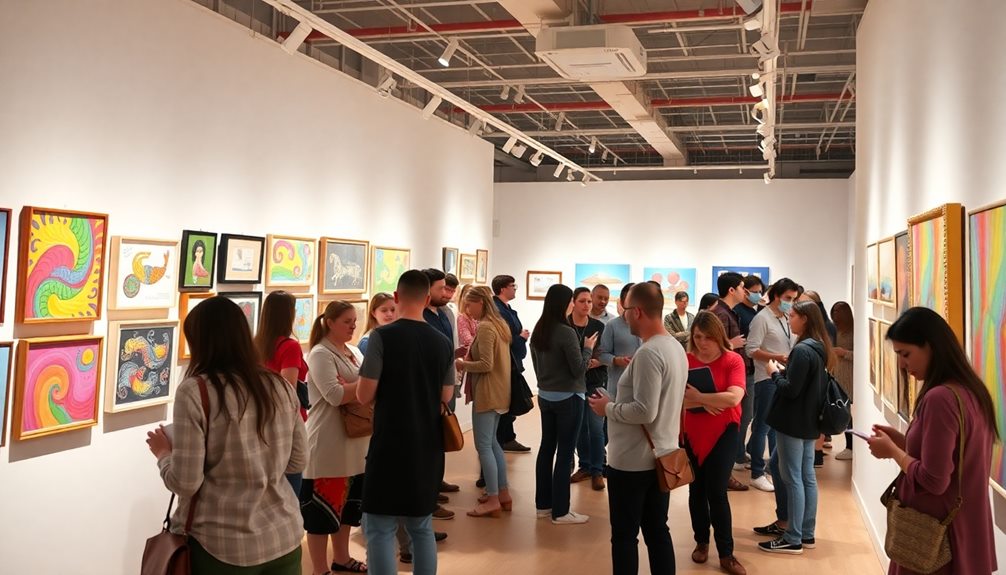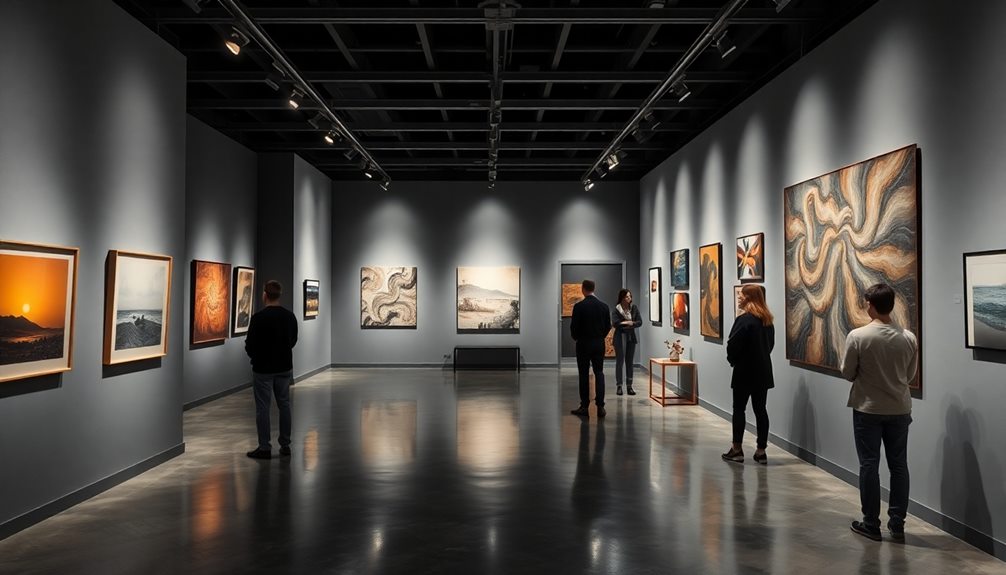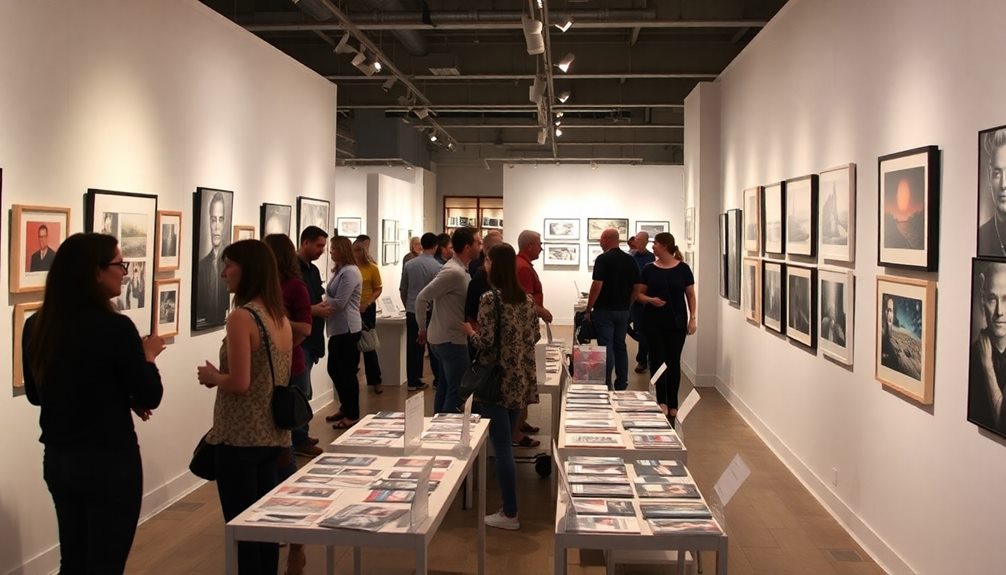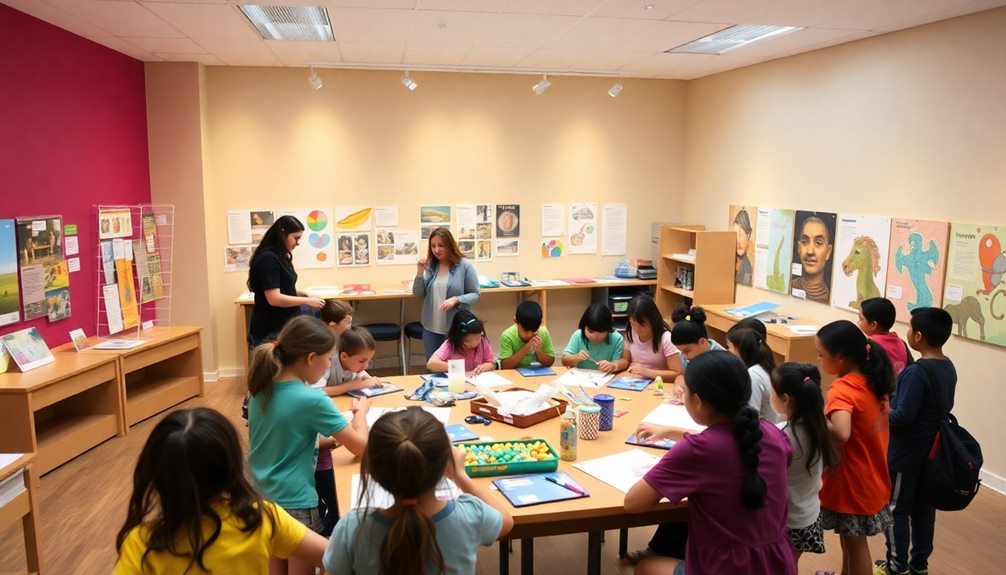Understanding gallery curation is all about how you create meaningful experiences through art. As a curator, you select and arrange artworks to tell a compelling story. You'll develop interpretive materials that enhance visitor understanding and engage with communities to connect local narratives. Good design principles guarantee that exhibitions flow well and are accessible to everyone. By using technology and incorporating audience feedback, you can boost engagement. You also need to be aware of current trends in curation, such as sustainability and immersive experiences. Explore further, and you'll uncover more strategies for effective gallery curation.
Key Takeaways
- Curators select and arrange artworks to create engaging narratives that enhance visitor understanding and appreciation of art.
- Audience engagement strategies include tailored presentations, immersive experiences, and community involvement to foster deeper connections with the artwork.
- Effective exhibition design considers layout, traffic flow, lighting, and accessibility to optimize visitor experience and interaction with the art.
- Trends in art curation feature technology integration, community-focused exhibitions, and sustainability efforts to reflect contemporary cultural dialogues.
- Distinctions between gallery types, such as commercial and non-profit, influence curatorial approaches and artist engagement.
Role of the Curator

In the world of art exhibitions, the curator plays a pivotal role in shaping the viewer's experience. You'll find that curators are responsible for selecting artworks and determining how they're arranged in the exhibition space. This arrangement isn't random; it's designed to create an engaging narrative that captures your interest and invites exploration.
The role of a curator also involves creating interpretive materials, like labels and texts, which provide context and enhance your understanding of the artworks. They collaborate closely with artists, collectors, and other stakeholders to guarantee that each exhibition aligns with artistic intentions and logistical needs. This teamwork guarantees a cohesive experience for you as a visitor.
Moreover, curators often serve as educators, facilitating discussions about the artworks and their significance. This dialogue enriches your experience and deepens your appreciation of the art on display.
To effectively manage these exhibitions and engage audiences like you, curators need a strong foundation in art history and museum studies, often gained through internships or fellowships.
Ultimately, the role of a curator is essential in transforming an ordinary visit into an extraordinary journey through art.
Crafting Exhibition Narratives

Exhibition narratives weave together a central theme that connects diverse artworks, guiding you through a cohesive visual journey. In the art of curation, crafting a compelling narrative is essential. It starts by establishing a central theme, allowing you to engage with the works on display meaningfully. Descriptive labels, audio guides, and digital media enrich storytelling, providing context that invites deeper interpretation.
Think of the selection and sequencing of exhibits as chapters in a book; they should mimic a narrative structure. This approach helps you experience the exhibition as a progression of ideas or emotions. Each piece builds upon the last, enhancing your understanding and appreciation of the overarching theme.
Continuous dialogue with you, facilitated through interactive elements and artist statements, encourages engagement and enriches the educational value of your experience. Successful narratives not only highlight individual artistic intentions but also reflect broader cultural or historical contexts, fostering meaningful connections between the art and you as an audience member.
Ultimately, the art of curation transforms an exhibition into a compelling story that resonates long after you've left the gallery.
Audience Engagement Strategies

Crafting a compelling narrative sets the stage for effective audience engagement strategies that bring exhibitions to life. Understanding your audience demographics is essential; it allows you to tailor presentation styles and narratives. You can employ visitor data analysis and surveys to fine-tune these strategies, ensuring diverse engagement.
Interactive displays and community-driven exhibitions attract younger audiences, while scholarly panels cater to academics. Incorporating immersive elements like guided tours and technology—think QR codes—encourages exploration. Participatory activities further enhance the experience, making visitors feel involved.
To maintain this engagement, establish continuous feedback mechanisms. Provide opportunities for visitor surveys and comments, enabling you to adapt future exhibitions based on audience input. This fosters a sense of community ownership and connection.
Here's a quick overview of effective audience engagement strategies:
| Strategy | Target Audience | Benefits |
|---|---|---|
| Interactive Displays | Younger Audiences | Increased Inclusivity |
| Community-Driven Exhibits | Local Communities | Enhanced Connection |
| Guided Tours | General Visitors | Immersive Experiences |
| Visitor Surveys | All Audiences | Continuous Improvement |
Design Principles for Exhibitions

Designing an exhibition requires careful consideration of principles that enhance both aesthetics and visitor experience. Curators often focus on strategic layouts that balance beauty and practicality, guaranteeing a cohesive flow throughout the space. By paying attention to traffic flow, they prevent congestion, allowing visitors to appreciate artworks individually and collectively.
Sight lines play a notable role in guiding viewer attention, directing focus to key pieces. Creative display methods, such as varying heights and innovative mounting solutions, can maximize space utilization and encourage interaction. Curators often utilize these techniques to engage visitors more deeply with the artwork.
Proper lighting design is essential too; it prioritizes visibility while protecting sensitive materials from excessive exposure, often through smart glass applications. Color schemes also contribute considerably to the exhibition's overall aesthetic.
Accessibility is another vital consideration. Curators often guarantee that all visitors, regardless of physical ability, can fully engage with the exhibition.
Trends in Art Curation

As curators refine their design principles to enhance visitor experience, they're also embracing new trends that shape the future of art curation. One significant trend is the increasing use of technology, including virtual and augmented reality, which creates interactive and immersive experiences. This technology not only fosters deeper connections between artworks and audiences but also increases accessibility to exhibitions.
Another rising trend is the focus on community-based exhibitions. These initiatives reflect local narratives and integrate diverse voices, ensuring that curation resonates with varied perspectives.
Curators are also adopting cross-disciplinary approaches, blending art with fields like science and technology, which aligns better with contemporary societal contexts and expectations.
Sustainability is becoming a priority as well. Curators are considering eco-friendly materials and methods in their installations, responding to the growing demand for environmentally conscious practices.
These trends in art curation indicate a shift towards more engaging, relevant, and responsible exhibitions, ensuring that art remains an essential part of community dialogue and cultural expression.
Types of Art Galleries

When exploring the types of art galleries, you'll notice distinct categories like commercial and non-profit galleries, each with unique missions and funding sources.
Artists-run galleries offer a platform for creators to showcase their work independently, while vanity galleries often prioritize profit over genuine community engagement.
Understanding these differences can help you navigate the art world more effectively.
Commercial vs. Non-Profit Galleries
Art galleries come in various forms, but two primary types stand out: commercial and non-profit galleries. Understanding the differences between these two can help you navigate the art world more effectively.
1. Commercial Galleries: These galleries operate for profit, representing artists and earning commissions from sales. They actively scout new talent and promote art exhibitions to enhance their offerings. Their primary focus is the sale of artworks.
2. Non-Profit Galleries: In contrast, non-profit galleries concentrate on community engagement and cultural missions. They often rely on donations and grants rather than sales, aiming to facilitate art exhibitions that reflect local narratives and support emerging artists.
These galleries provide a platform for artists who may not have access to commercial venues, fostering diversity and inclusivity.
3. Business Models: The business model of commercial galleries revolves around financial returns, while non-profits prioritize educational and cultural enrichment over profit-making.
Artists-Run and Vanity Galleries
How do artists navigate the diverse landscape of galleries available to them? Understanding the differences between artists-run and vanity galleries can notably impact your career.
Artists-run galleries, established by fellow artists, allow you to showcase your work with greater creative control. Here, you can curate art exhibitions that reflect your artistic vision and engage directly with your audience, fostering a sense of community and collaboration.
On the other hand, vanity galleries operate primarily on membership fees, which can create barriers for emerging artists like yourself. In these spaces, you often pay to exhibit, prioritizing profit over artistic merit. This model can dilute the quality of art exhibitions, as the focus shifts from artistic integrity to commercial success.
Both types of galleries offer platforms for displaying your work, but they serve different purposes in the art ecosystem. By recognizing these distinctions, you can make informed decisions about where to apply for representation, aligning your goals with the right gallery type.
Ultimately, your choice will shape how your art reaches its audience and how it's perceived in the broader art community.
Galleries vs. Museums

Galleries and museums serve distinct roles in the art world, each offering unique experiences and objectives. When you explore these two spaces, it's crucial to understand their differences:
- Commercial vs. Cultural: Galleries primarily focus on the commercial aspect, displaying and selling artworks, while museums prioritize cultural preservation and education.
- Audience and Access: Galleries typically target specific audiences for transactions, acting as intermediaries between artists and collectors. In contrast, museums maintain collections accessible to the public, showcasing broader historical and cultural narratives.
- Funding and Mission: Galleries often operate as private businesses, seeking profit through sales. Museums, however, can be publicly or privately funded, emphasizing community engagement and educational missions.
Building an Exhibition Program

Building a successful exhibition program requires a gallery's clear vision and understanding of its audience. You'll need to define your brand message and carefully select artists through a mix of invite-only, open calls, and talent scouting methods. This diverse approach helps you create a dynamic lineup that resonates with your community.
Long-term relationships with artists are vital for sustaining your gallery's operations. By providing behind-the-scenes support like marketing and customer relations, you foster an environment where artists thrive.
Each exhibition you curate should engage audiences, linking artworks with compelling narratives that align with your gallery's thematic focus.
As you build your exhibition program, manage your sales strategies effectively. Balancing exhibition planning with financial goals is important, so make certain you execute art transactions, and handle packing and transporting artworks seamlessly.
A successful program often involves a collaborative approach, where you work closely with artists to align their visions with your gallery's objectives. This teamwork results in impactful displays that captivate your audience, making your exhibition program not just a showcase, but an enriching experience for everyone involved.
Community Involvement in Curation

Community involvement in curation opens the door for you to engage with local artists and create collaborative programs that reflect your unique cultural identity.
By working together, you can develop exhibitions that resonate with local narratives and foster a deeper connection among residents.
This approach not only enhances the relevance of the gallery but also strengthens community ties and boosts attendance.
Engaging Local Artists
Frequently engaging local artists in gallery curation not only strengthens connections within the area but also brings diverse perspectives to exhibitions, fostering digital creativity that can enhance community involvement.
This collaboration enhances the representation of local narratives, making the art more relatable to your community. Here are a few ways you can engage local artists effectively:
- Host Community Events: Organize artist talks or workshops that allow for interaction between local artists and the public. This fosters dialogue and deepens understanding of the artwork.
- Volunteer Opportunities: Involve local residents in exhibition planning and installation. This not only builds community involvement but also provides valuable experience in the art curation process.
- Establish Partnerships: Collaborate with local organizations and schools to enhance your connection with artists. This can lead to innovative exhibitions that resonate with the community's values and interests.
Collaborative Community Programs
Engaging local artists lays the groundwork for collaborative community programs that enrich gallery curation.
These programs involve partnerships with local organizations, schools, and artists to create exhibitions that truly reflect your community's narratives and values. As a visitor, you'll notice that involving community members in the curation process fosters a sense of ownership, strengthening your connection to the artworks displayed.
This approach often leads to increased visitor engagement and attendance, making the gallery experience more vibrant.
Community events like workshops or meet-the-artist sessions offer direct interaction between artists and art lovers, enhancing your understanding and appreciation of the art.
Additionally, incorporating feedback mechanisms allows galleries to gather insights from you and others, informing future exhibitions and improving overall visitor experiences.
Marketing and Promotion Strategies

To successfully navigate the competitive art world, galleries need to embrace a variety of marketing and promotion strategies that blend both online and offline channels.
These strategies not only enhance visibility for represented artists but also engage diverse audiences, ultimately leading to increased engagement and sales.
Here are three effective marketing strategies you can implement:
- Leverage Social Media: Utilize platforms like Instagram and Facebook to showcase artworks dynamically. Regular posts, stories, and interactive content can draw attention and create meaningful connections with potential buyers, utilizing powerful persuasive words to captivate customers.
- Host Virtual Exhibitions: By creating virtual exhibitions, you can reach global audiences beyond your physical location. This enhances accessibility and allows art enthusiasts to engage with your gallery anytime, anywhere.
- Engage the Community: Collaborate with local businesses and organizations to amplify your efforts. Partnering with community events can increase foot traffic and foster greater involvement in gallery happenings.
Implementing targeted email marketing campaigns can also keep your subscribers informed about upcoming exhibitions and events, driving attendance and boosting sales.
Frequently Asked Questions
How to Curate a Gallery?
To curate a gallery, you'll need to define your theme, select compelling artworks, and organize the layout. Engage your audience with interactive elements, clear messaging, and community involvement to create a memorable experience.
What Are the Basics of Curation?
When you think about curation, envision selecting, arranging, and interpreting. You're choosing artworks, shaping narratives, and engaging audiences. It's about understanding art history, designing spaces, and creating connections that resonate with diverse perspectives.
What Does a Gallery Curator Do?
As a gallery curator, you select and organize artworks for exhibitions, create interpretive materials, manage installation logistics, and engage the community through programs. Your role enhances the visitor experience and fosters dialogue around art.
What Does It Mean to Curate a Gallery?
Curating a gallery isn't just hanging art; it's weaving stories. You'll select pieces, arrange them thoughtfully, and create an experience that resonates. It's about merging aesthetics with meaning, engaging viewers in a lasting dialogue.
Conclusion
To sum up, understanding gallery curation isn't just for art professionals; it's for anyone passionate about culture and community. While some might think curation's solely an expert's domain, your unique perspective can enrich the dialogue around exhibitions. By engaging with the curation process, you contribute to a vibrant cultural landscape, fostering connections among artists, audiences, and the community. So, engage and explore how your voice can shape the stories told through art.









